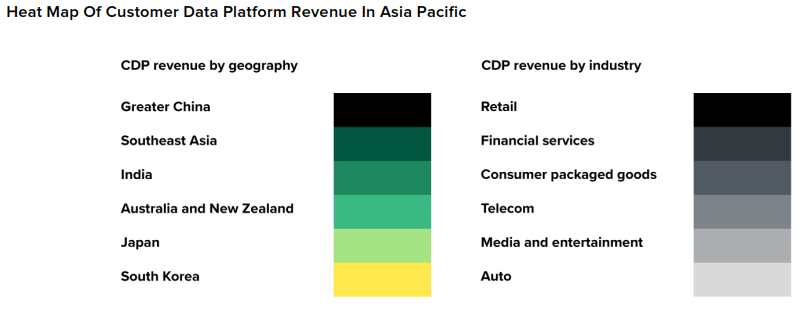All you need to know about the state of CDP in the region and why APAC marketers drive CDP investment.
How do you plan to gather customer data for your marketing strategies with the dissolution of third-party cookies? The answer is using customer data platforms.
Consumers’ increasing awareness about data privacy and more stringent data privacy laws prompt marketers in the Asia Pacific (APAC) region to fuel their investments in customer data platforms (CDPs). APAC marketers recognize the importance of leveraging first-party data with the eradication of using third-party cookies in capturing consumer data for lead generation, marketing, and sales purposes.
What are CDPs?
Forrester defines CDPs as dedicated platforms marketers can use to centralise customer data from various sources, simplify complex data processes, and make data available to systems of insight and engagement.
CDPs have data management, hygiene, enhancement and identity resolution capabilities. APAC marketers can use CDPs to combine disparate data sources, improve insights-driven decision-making, and orchestrate relevant data to deliver personalized experiences.
APAC Marketers’ Top Priority
CDPs are one of the top marketing technologies (martech) priorities of APAC marketers. Forrester reported in the 2021 Global Marketing Survey that 23% of APAC B2C marketing decision-makers use CDPs, and 26% of respondents plan to implement them in the next 12 months.
Marketers face massive headwinds amidst data deprecation, wanting to gather zero- and first-party customer data for building direct relationships and marketing purposes. In Forrester’s 2022 Q1 B2C Marketing CMO Pulse Survey, about 76% of B2C marketing respondents focus more on collecting first-party data due to restricted data access or data deprecation.
CDPs allow APAC marketers to make use of customer data to deliver better marketing strategies and yield more positive business outcomes. A recent Forrester Trend report outlines the state of CDPs in the region by geography, industry, and type and explains APAC’s five CDP use cases.
Marketing professionals can use these valuable insights to develop their first-party data strategy and accelerate their CDP investments. Check out the key findings of this Forrester report below.
The Hottest CDP Markets: Greater China and Southeast Asia
CDP vendors in the region generate the highest revenue in Greater China and Southeast Asia. Because these two are the largest, fast-growing markets, marketers deal with large customer data volumes.
In Forrester’s 2023 Predictions, APAC’s cross-border commerce is expected to grow by 20%, making the region a fast-becoming innovation hub in payments and commerce. India, China, and Southeast Asia embrace modern payment networks, threatening the 50-year-old SWIFT system. The Regional Comprehensive Economic Partnership or RCEP agreement removes tariffs and reduces restrictions and barriers to regional trade, which further strengthens cross-border commerce.
A powerful regional trade opens more business opportunities, which means APAC companies must prepare to manage more data volumes. That’s when CDP platforms can help businesses in the hottest markets thrive and stay competitive.
China and Southeast Asia are the top CDP markets that offer more opportunities for homegrown CDP vendors to grow because of their market intricacies and unique digital ecosystems. These vendors have existing Martech and AdTech offerings, which rapidly expand their CDP business in the region.
The CDP Adoption Front-Runners: Retail and Financial Services
CDP vendors in the region generate the highest revenue from retail and financial services firms. The marketers in these industries have more abundant data assets than others. Therefore, they are more receptive to gathering and utilizing first-party data and ready to invest in CDPs. Many CDP vendors were able to build use cases for retail and financial services, so they could share more best practices.
CDP platforms help marketers better position the promising benefits of retail consumer banking. Because 71% of surveyed business and technology professionals said that they prioritize improving customer experience and driving customer loyalty, CDPs play a critical role in attaining these priorities in retail consumer banking.

The Most Common CDP Types: Orchestration and Automation
Forrester categorizes CDP vendors in the region into four based on their primary functionality: orchestration, automation, data management, and measurement. More CDP vendors have orchestration and automation functionality than data management or measurement. For this reason, there’s a high demand for the functionality to support campaign orchestration among APAC marketers.
CDP Preparation and Implementation
A CDP is a valuable marketing technology investment that costs an average of a few hundred thousand US dollars every year. This tool is crucial to attaining data-driven marketing and making the most of their first-party data. But obtaining a positive return on CDP requires proper preparation and implementation.
Using CDP can improve personalization, targeting, segmentation, and responsiveness by concentrating on data, process, and adoption. A packaged CDP solution instantly provides access to excellent functionality, customer support, ongoing development, and an existing ecosystem that is difficult to replicate internally.
But it’s not enough to have a packaged CDP solution. Marketing leaders must create a cross-functional CDP team to fully understand data, technology, use cases, and relevant strategies to ensure accountability and smooth CDP execution.


















